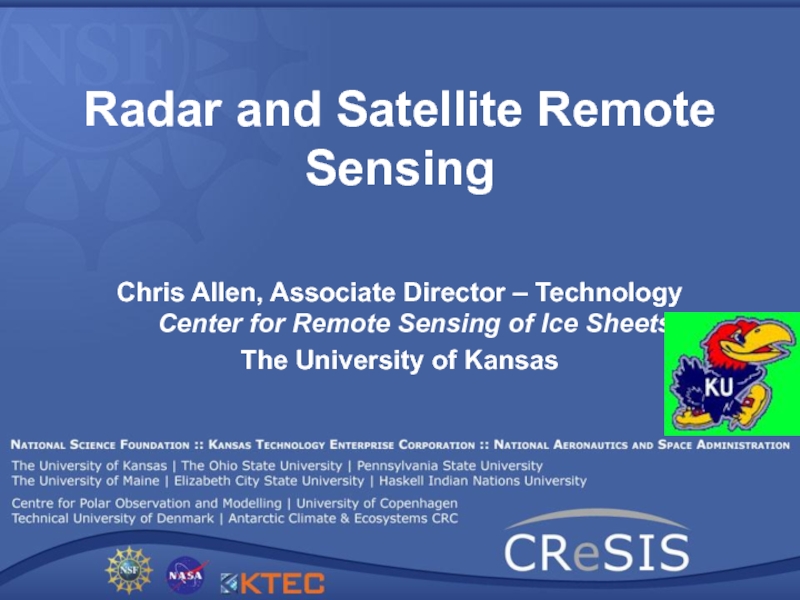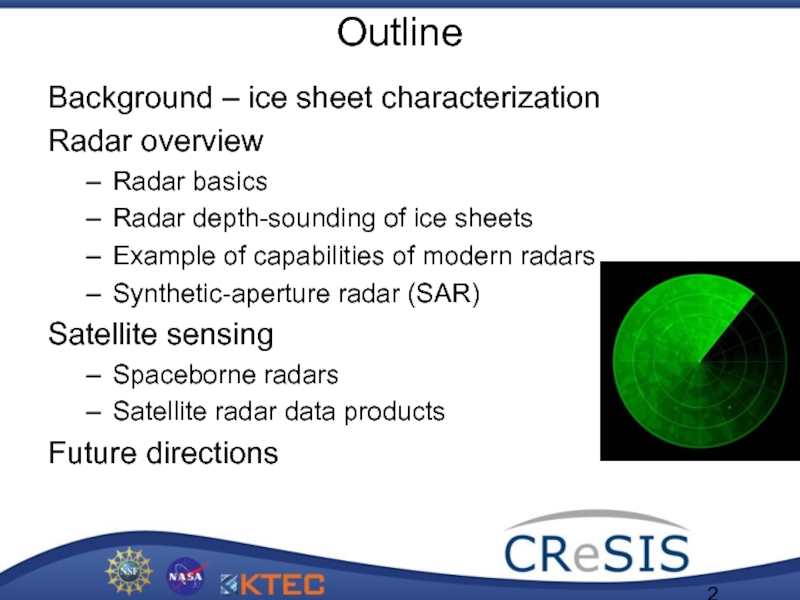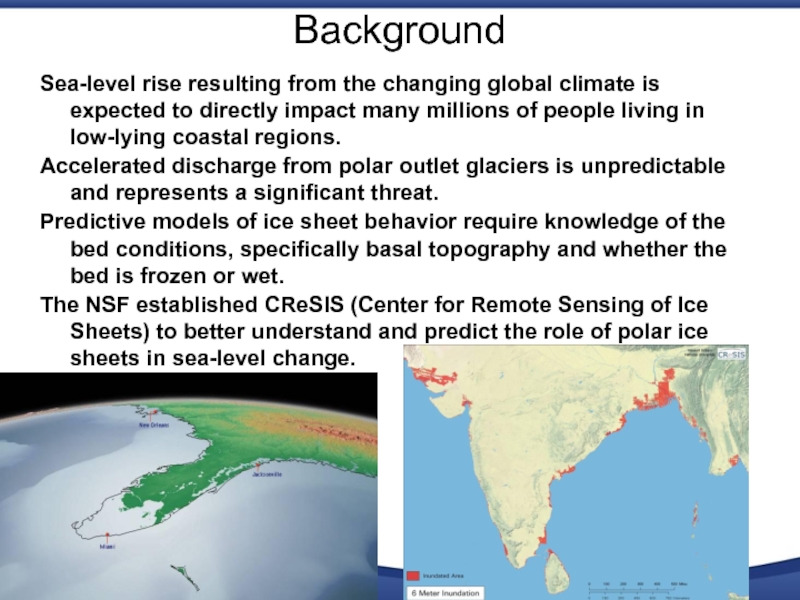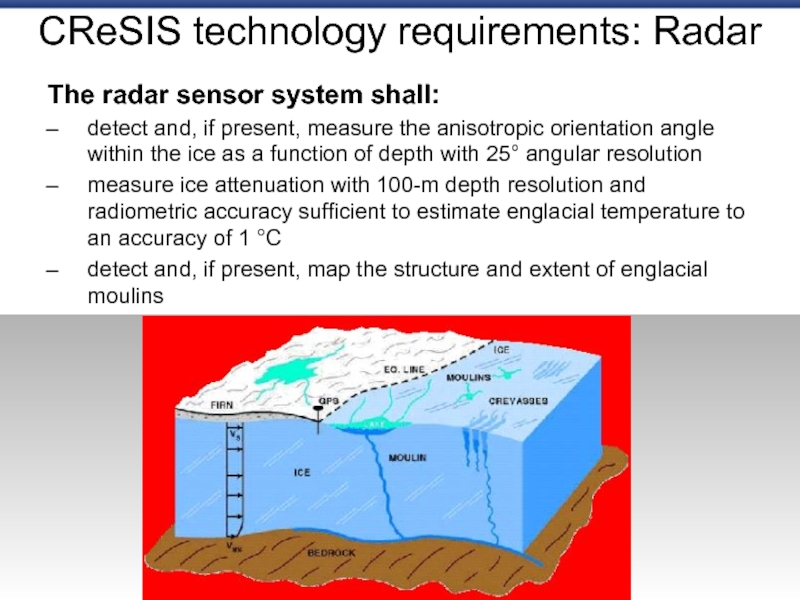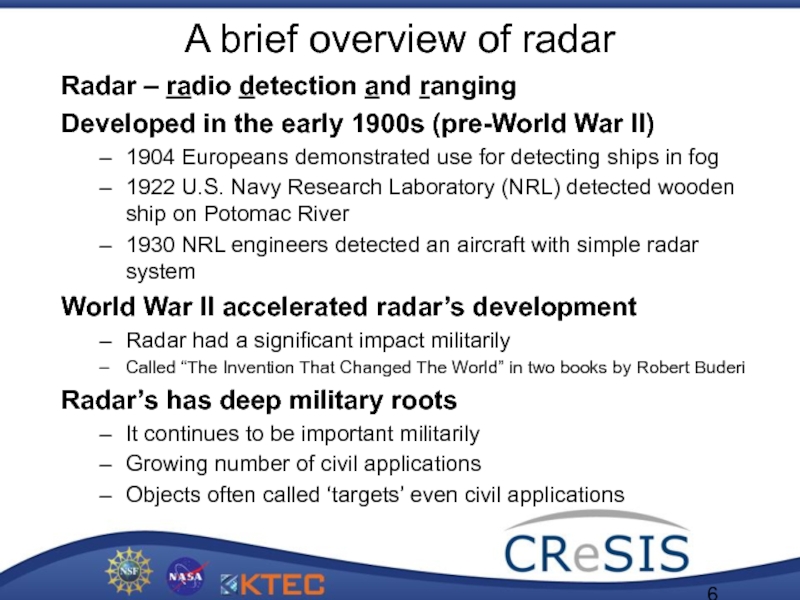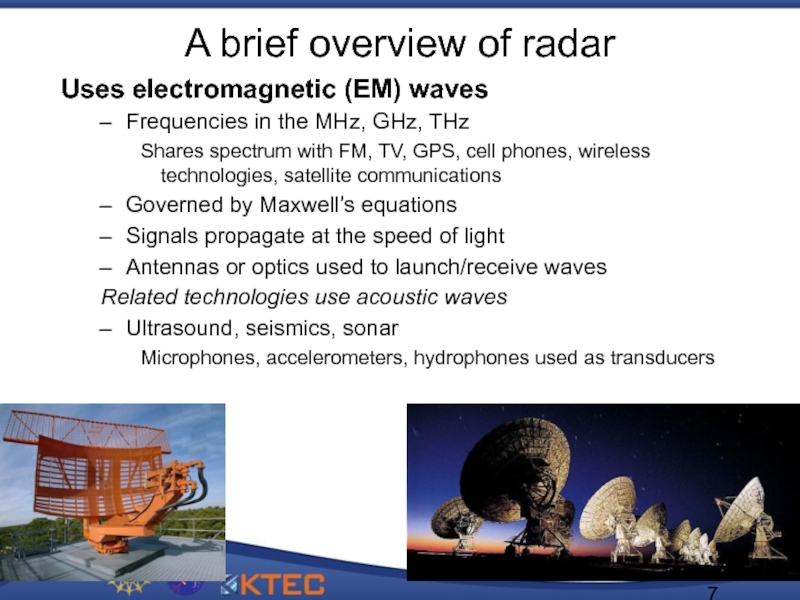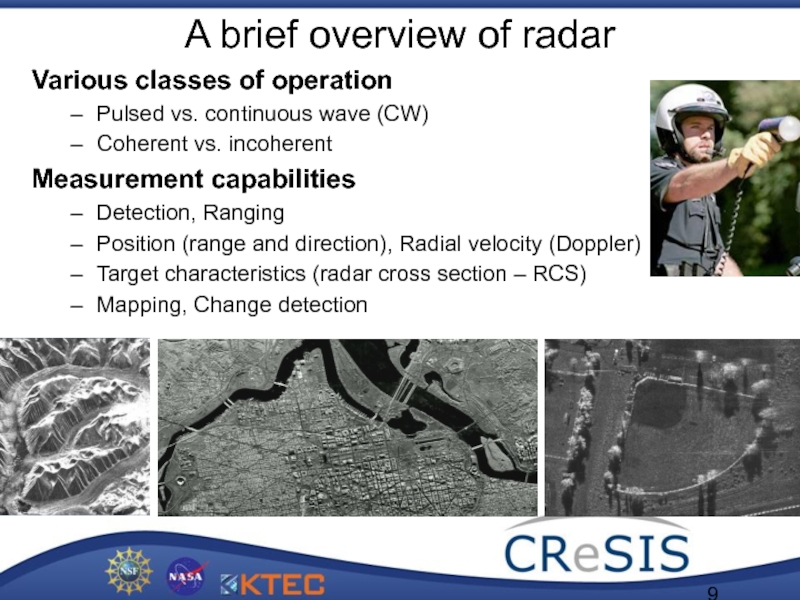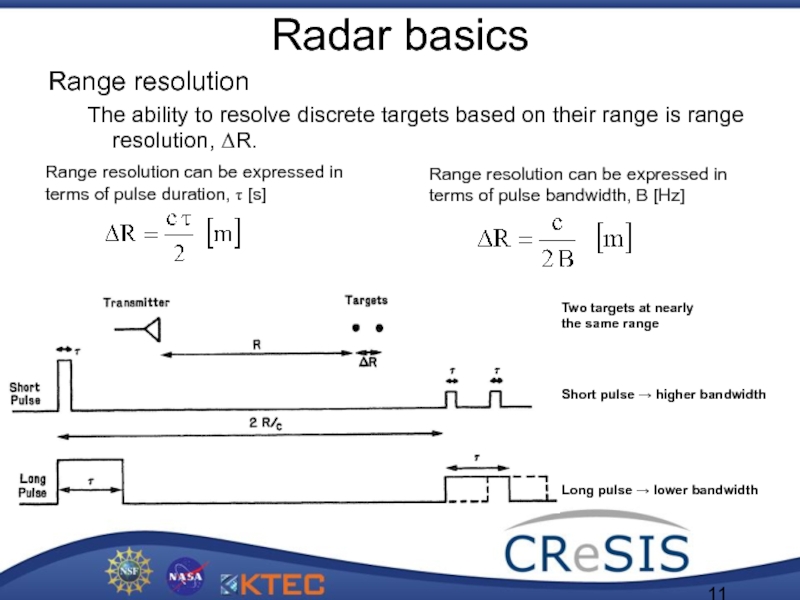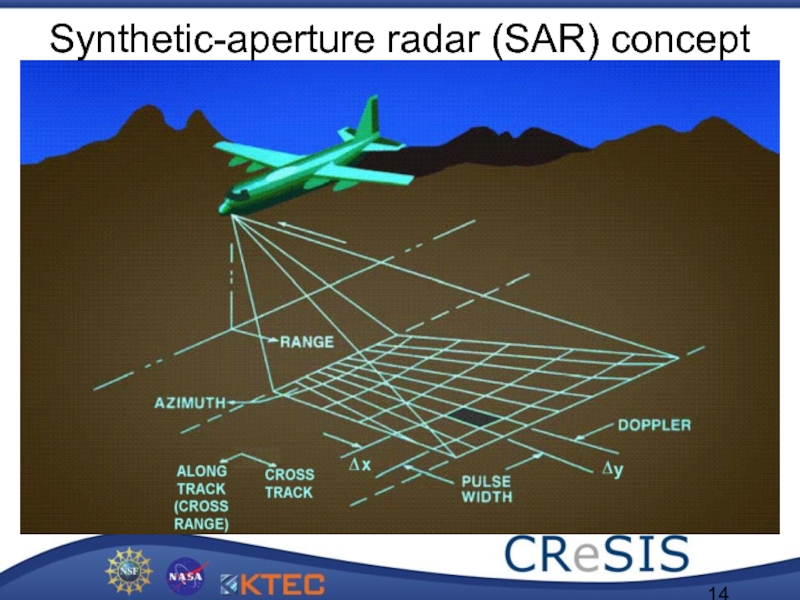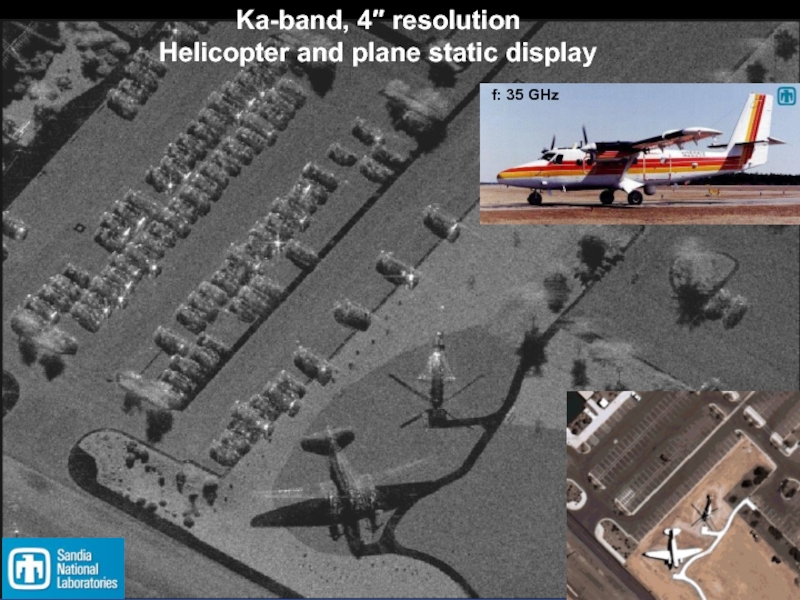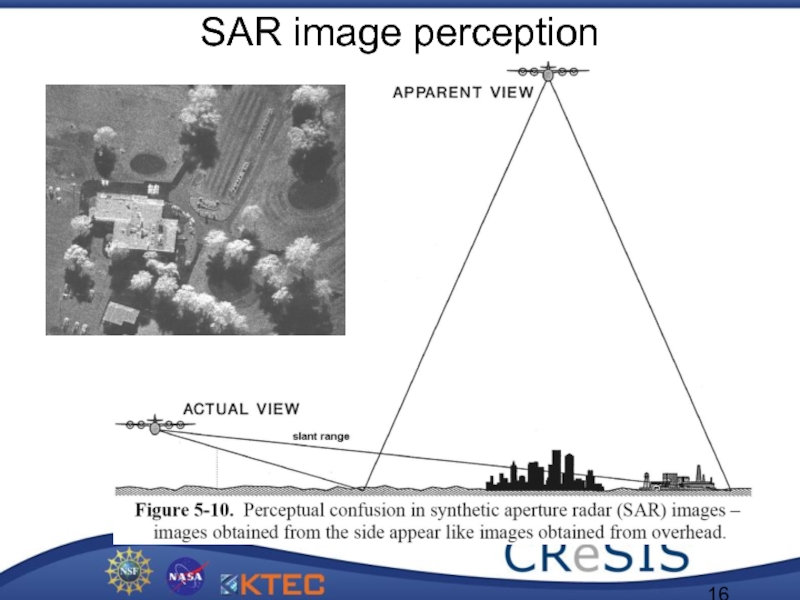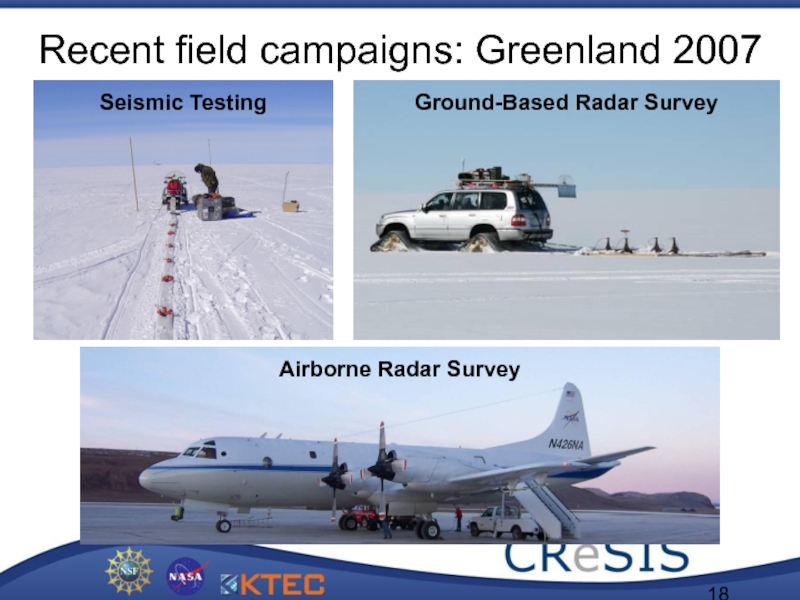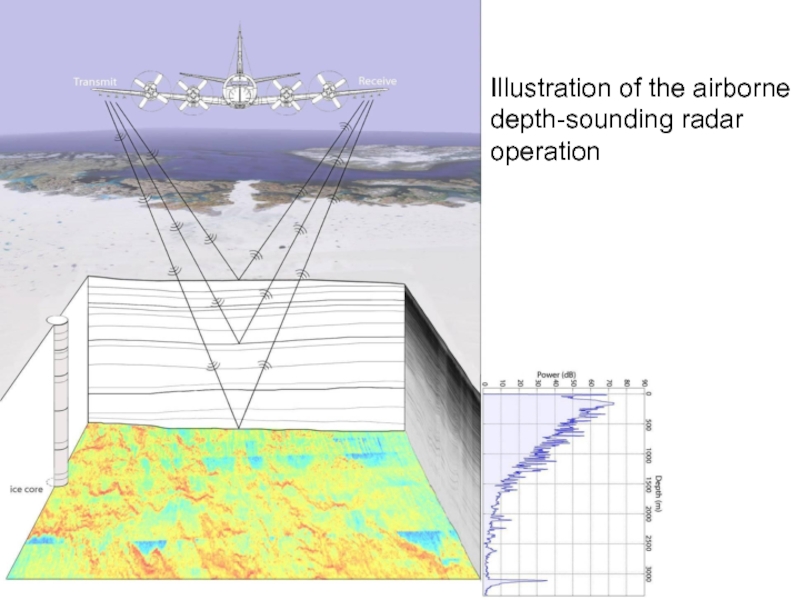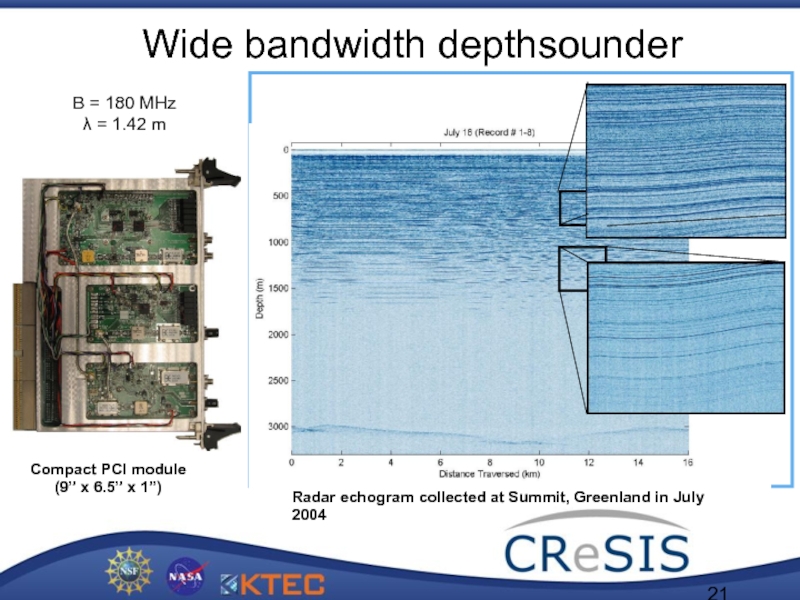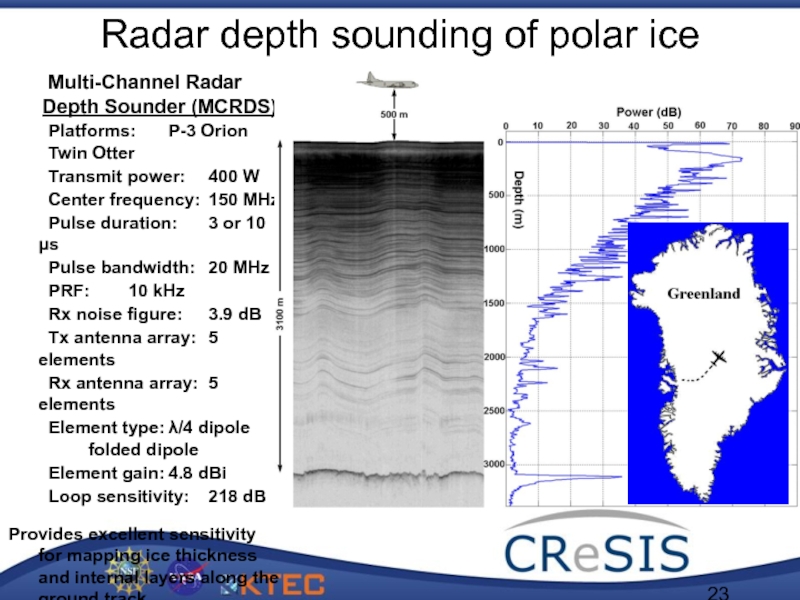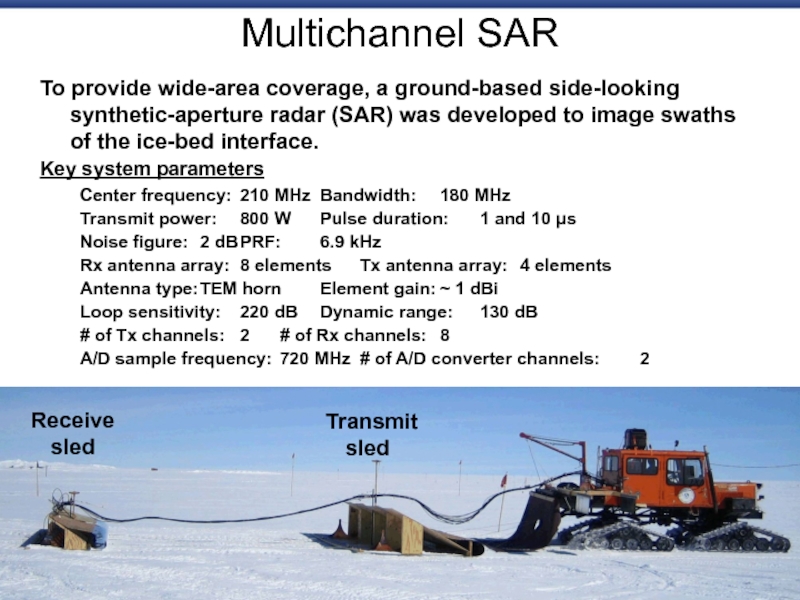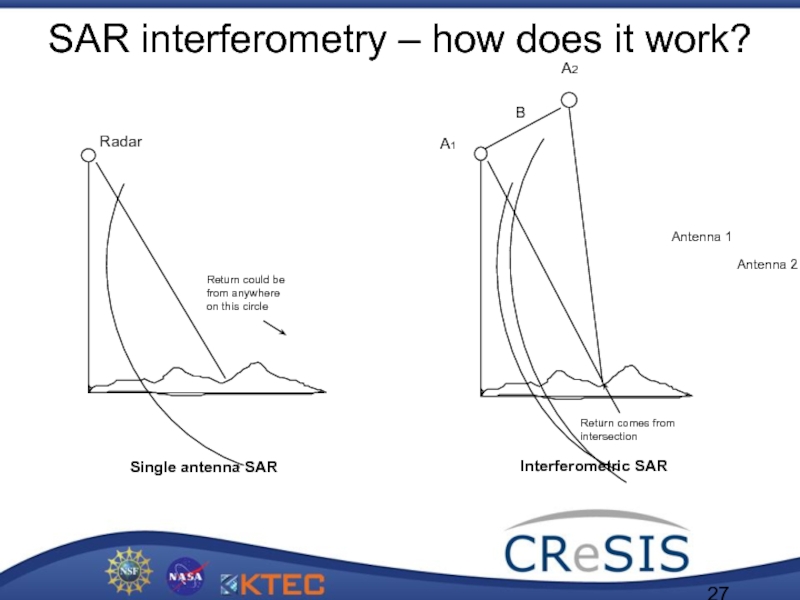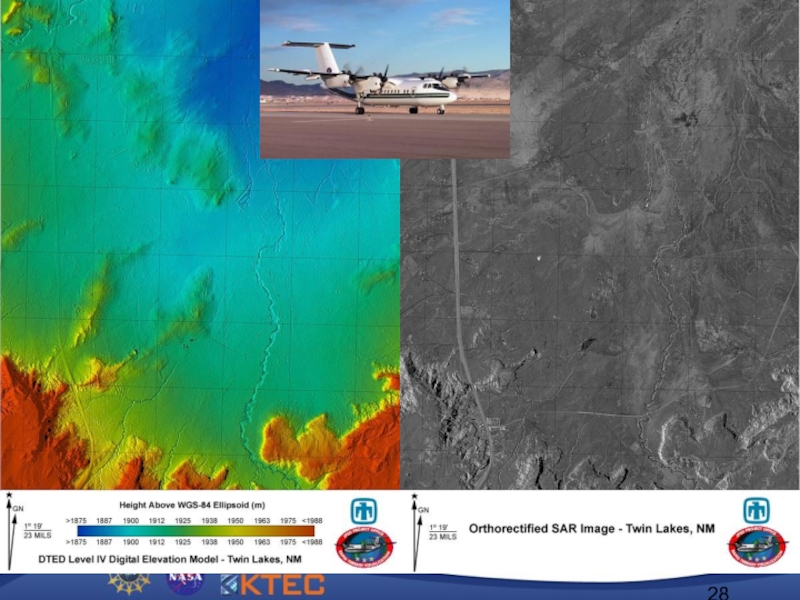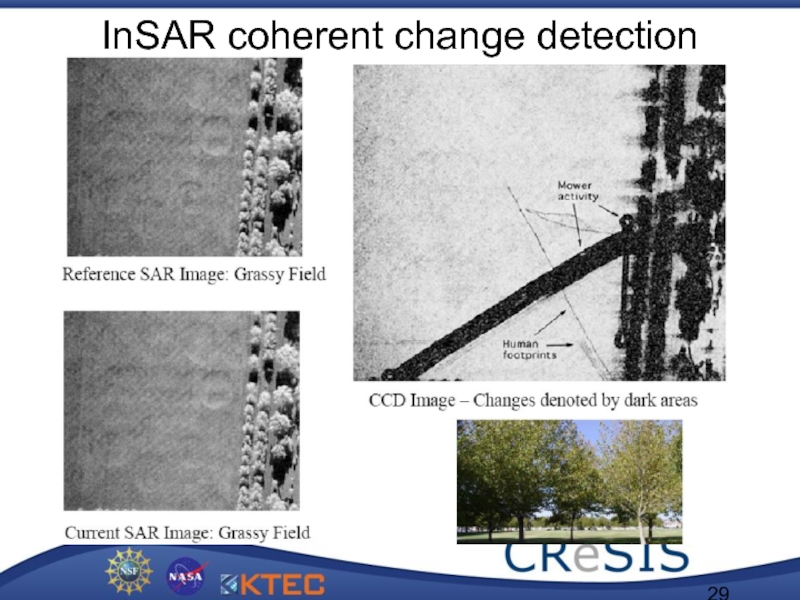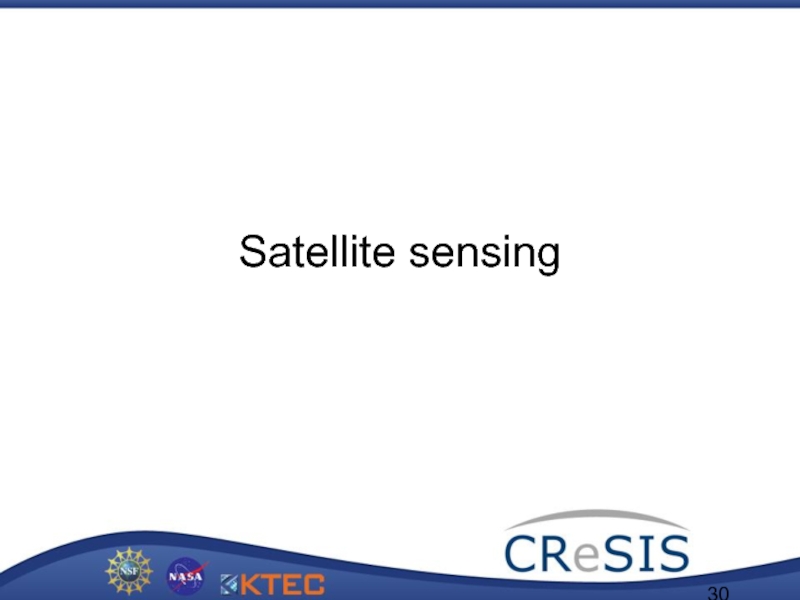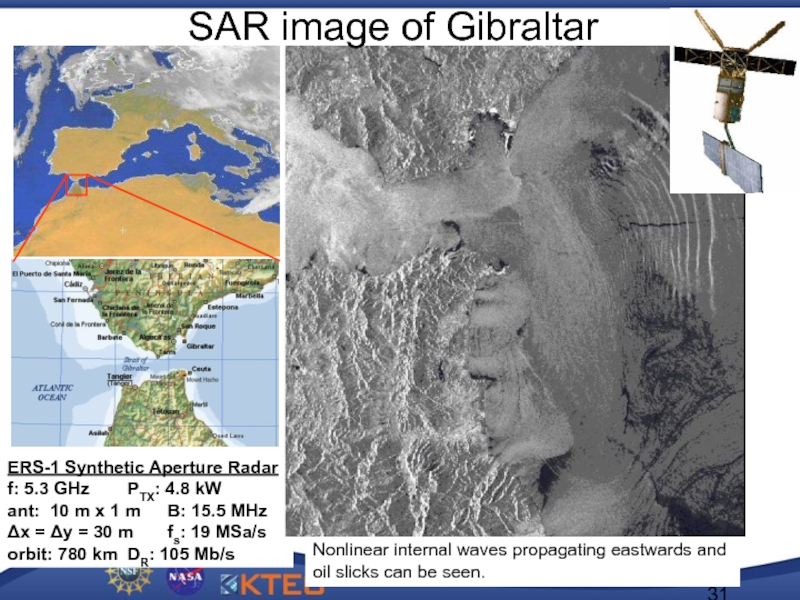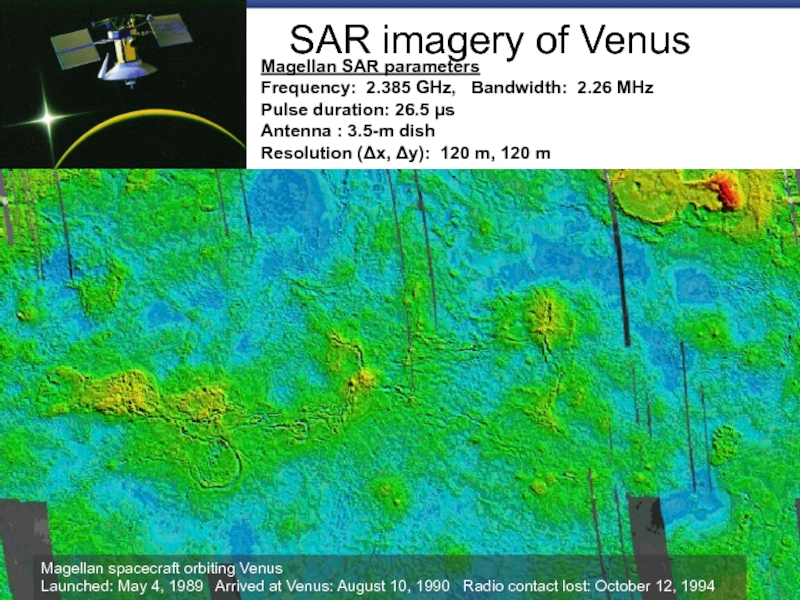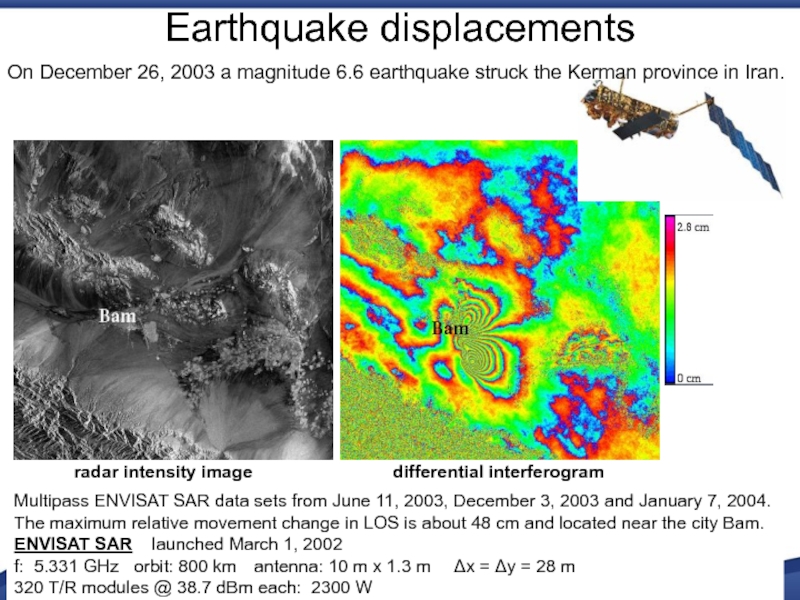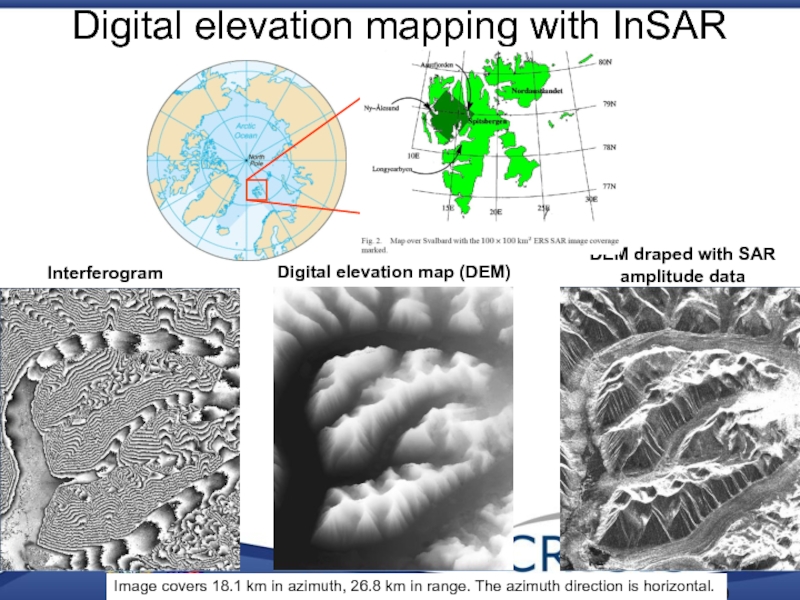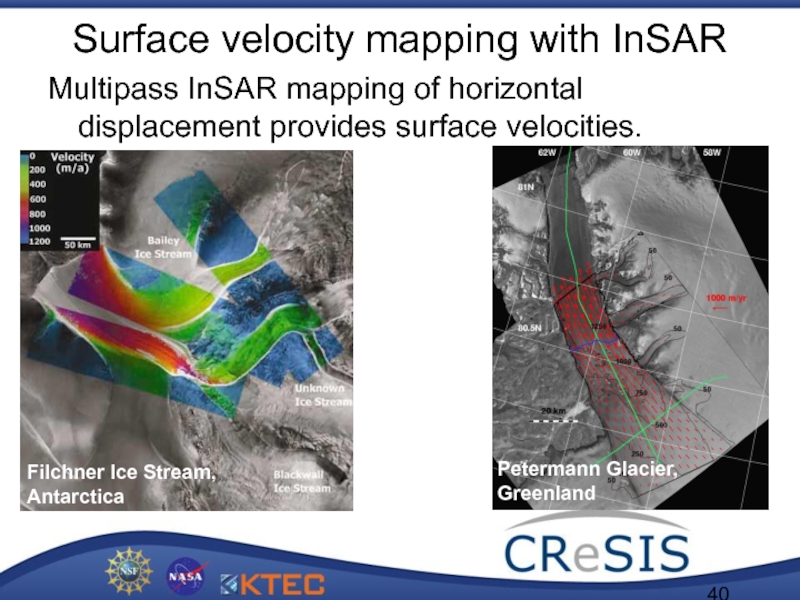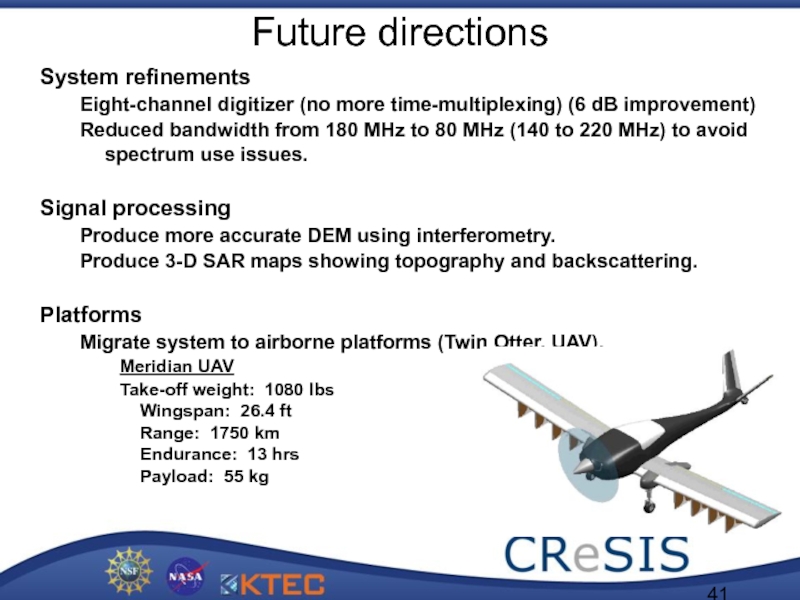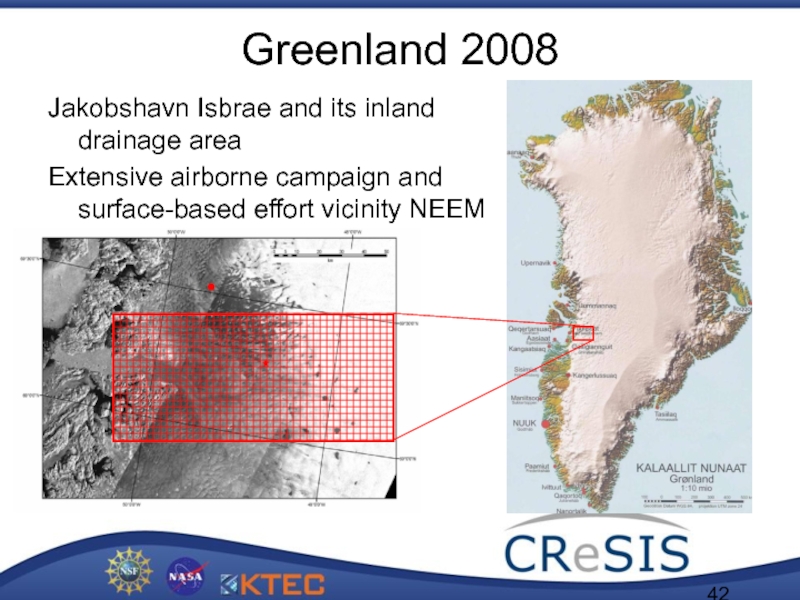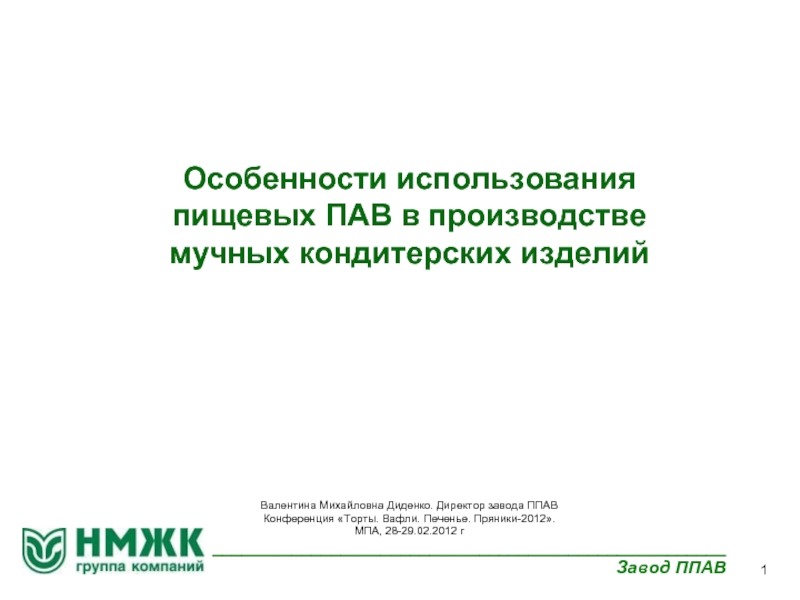- Главная
- Разное
- Дизайн
- Бизнес и предпринимательство
- Аналитика
- Образование
- Развлечения
- Красота и здоровье
- Финансы
- Государство
- Путешествия
- Спорт
- Недвижимость
- Армия
- Графика
- Культурология
- Еда и кулинария
- Лингвистика
- Английский язык
- Астрономия
- Алгебра
- Биология
- География
- Детские презентации
- Информатика
- История
- Литература
- Маркетинг
- Математика
- Медицина
- Менеджмент
- Музыка
- МХК
- Немецкий язык
- ОБЖ
- Обществознание
- Окружающий мир
- Педагогика
- Русский язык
- Технология
- Физика
- Философия
- Химия
- Шаблоны, картинки для презентаций
- Экология
- Экономика
- Юриспруденция
Radar and Satellite Remote Sensing презентация
Содержание
- 1. Radar and Satellite Remote Sensing
- 2. of 43 Outline Background – ice
- 3. of 43 Background Sea-level rise resulting
- 4. of 43 CReSIS technology requirements: Radar
- 5. of 43 CReSIS technology requirements: Radar
- 6. of 43 A brief overview of
- 7. of 43 Uses electromagnetic (EM) waves
- 8. of 43 Active sensor Provides its
- 9. of 43 Various classes of operation
- 10. of 43 Radar basics Transmitted signal
- 11. of 43 Radar basics Range resolution
- 12. of 43 Radar basics Doppler frequency
- 13. of 43 Radar basics
- 14. of 43 Synthetic-aperture radar (SAR) concept
- 15. of 43 f: 35 GHz Ka-band, 4″ resolution Helicopter and plane static display
- 16. of 43 SAR image perception
- 17. of 43 Continuous improvements on depthsounder
- 18. of 43 Recent field campaigns: Greenland
- 19. of 43 Illustration of the airborne depth-sounding radar operation
- 20. of 43 Surface clutter Radar height
- 21. of 43 Wide bandwidth depthsounder Radar
- 22. of 43 Accumulation radar system Comparison
- 23. of 43 Radar depth sounding of
- 24. of 43 Multichannel SAR To provide
- 25. of 43 Depthsounder data The slower
- 26. of 43 SAR image mosaic First
- 27. of 43 SAR interferometry – how does it work? Single antenna SAR Interferometric SAR
- 28. of 43
- 29. of 43 InSAR coherent change detection
- 30. of 43 Satellite sensing
- 31. of 43 ERS-1 Synthetic Aperture Radar
- 32. of 43 SAR imagery of Venus
- 33. of 43 Synthetic Aperture Radar Overview Radarsat-1
- 34. of 43 SAR imaging characteristics Range
- 35. of 43 Single-pass interferometry Single-pass interferometry. Two antennas offset by known baseline.
- 36. of 43 Topographic map of North
- 37. of 43 Multipass interferometric SAR
- 38. of 43 Earthquake displacements Multipass ENVISAT
- 39. of 43 Digital elevation mapping with
- 40. of 43 Surface velocity mapping with
- 41. of 43 Future directions System refinements
- 42. of 43 Greenland 2008 Jakobshavn Isbrae
- 43. of 43
Слайд 1Radar and Satellite Remote Sensing
Chris Allen, Associate Director – Technology
Center for
The University of Kansas
Слайд 2 of 43
Outline
Background – ice sheet characterization
Radar overview
Radar basics
Radar depth-sounding of
Example of capabilities of modern radars
Synthetic-aperture radar (SAR)
Satellite sensing
Spaceborne radars
Satellite radar data products
Future directions
Слайд 3 of 43
Background
Sea-level rise resulting from the changing global climate is
Accelerated discharge from polar outlet glaciers is unpredictable and represents a significant threat.
Predictive models of ice sheet behavior require knowledge of the bed conditions, specifically basal topography and whether the bed is frozen or wet.
The NSF established CReSIS (Center for Remote Sensing of Ice Sheets) to better understand and predict the role of polar ice sheets in sea-level change.
Слайд 4 of 43
CReSIS technology requirements: Radar
Technology requirements are driven by science,
The radar sensor system shall:
measure the ice thickness with 5-m accuracy to 5-km depths
detect and measure the depth of shallow internal layers (depths < 100 m) with 10-cm accuracy
measure the depth to internal reflection layers with 5-m accuracy
detect and, if present, map the extent of water layers and water channels at the basal surface with 10-m spatial resolution when the depth of the water layer is at least 1 cm
provide backscatter data that enables bed roughness characterization with 10-m spatial resolution and roughness characterized at a 1-m scale
Слайд 5 of 43
CReSIS technology requirements: Radar
The radar sensor system shall:
detect and,
measure ice attenuation with 100-m depth resolution and radiometric accuracy sufficient to estimate englacial temperature to an accuracy of 1 °C
detect and, if present, map the structure and extent of englacial moulins
Слайд 6 of 43
A brief overview of radar
Radar – radio detection and
Developed in the early 1900s (pre-World War II)
1904 Europeans demonstrated use for detecting ships in fog
1922 U.S. Navy Research Laboratory (NRL) detected wooden ship on Potomac River
1930 NRL engineers detected an aircraft with simple radar system
World War II accelerated radar’s development
Radar had a significant impact militarily
Called “The Invention That Changed The World” in two books by Robert Buderi
Radar’s has deep military roots
It continues to be important militarily
Growing number of civil applications
Objects often called ‘targets’ even civil applications
Слайд 7 of 43
Uses electromagnetic (EM) waves
Frequencies in the MHz, GHz, THz
Shares
Governed by Maxwell’s equations
Signals propagate at the speed of light
Antennas or optics used to launch/receive waves
Related technologies use acoustic waves
Ultrasound, seismics, sonar
Microphones, accelerometers, hydrophones used as transducers
A brief overview of radar
Слайд 8 of 43
Active sensor
Provides its own illumination
Operates in day and night
Largely
Involves both a transmitter and a receiver
Related technologies are purely passive
Radio astronomy, radiometers
Configurations
Monostatic
transmitter and receiver co-located
Bistatic
transmitter and receiver separated
Multistatic
multiple transmitters and/or receivers
Passive
exploits non-cooperative illuminator
Radar image of Venus
Bistatic
example
A brief overview of radar
Слайд 9 of 43
Various classes of operation
Pulsed vs. continuous wave (CW)
Coherent vs.
Measurement capabilities
Detection, Ranging
Position (range and direction), Radial velocity (Doppler)
Target characteristics (radar cross section – RCS)
Mapping, Change detection
A brief overview of radar
Слайд 10 of 43
Radar basics
Transmitted signal propagates at speed of light through
vp = c.
Travel time from antenna to target
R/c
Travel time from target back to antenna
R/c
Total round-trip time of flight
T = 2R/c
Tx: transmit
Rx: receive
Слайд 11 of 43
Radar basics
Range resolution
The ability to resolve discrete targets based
Short pulse higher bandwidth
Long pulse lower bandwidth
Two targets at nearly
the same range
Range resolution can be expressed in terms of pulse duration, t [s]
Range resolution can be expressed in terms of pulse bandwidth, B [Hz]
Слайд 12 of 43
Radar basics
Doppler frequency shift and velocity
Time rate of change
Aircraft flying straight and level
x = 0, y = 0, z = 2000 m
vx = 0, vy = 100 m/s, vz = 0
f = 200 MHz
Electrical phase angle,
Doppler frequency, fD
Radial velocity, vr
Target range, R
Wavelength, l
Слайд 17 of 43
Continuous improvements on depthsounder system. Annual measurement campaigns of
More advanced and compact radar systems developed as part of the PRISM project.
1993 - 2001
2001 - 2005
2005 - 2010
New radar systems developed to meet science needs.
Radar systems modified and miniaturized for UAV use.
2010 - 2015
Radar system size and weight reduction continues. Imaging radars developed.
2001
2004
2010
2015
stacked ICs or MCMs
Radar development timeline
3.7 ft3
7.1 ft3
0.23 ft3
< 0.01 ft3
Слайд 18 of 43
Recent field campaigns: Greenland 2007
Seismic Testing
Ground-Based Radar Survey
Airborne Radar
Слайд 20 of 43
Surface clutter
Radar height (H); ice surface height (h); Depth
For airborne (or spaceborne) radar configurations, radar echoes from the surface of the ice and mask the desired internal layer echoes or even the echo from the ice bed.
These unwanted echoes are called clutter.
Clutter refers to actual radar echoes returned from targets which are by definition uninteresting to the radar operators.
System geometry determines the regions whose clutter echo coincide with the echoes of interest.
Слайд 21 of 43
Wide bandwidth depthsounder
Radar echogram collected at Summit, Greenland in
Compact PCI module
(9” x 6.5” x 1”)
B = 180 MHz
= 1.42 m
Слайд 22 of 43
Accumulation radar system
Comparison between airborne radar measurements and ice
Simulated and measured radar response as a function of depth at the
NASA-U core site. The qualitative comparison of the plots is indicated using lines that connect the peaks of both the plots.
Compact PCI module
(9” x 6.5” x 1”)
B = 300 MHz
= 0.4 m
Слайд 23 of 43
Radar depth sounding of polar ice
Multi-Channel Radar
Depth Sounder
Platforms: P-3 Orion Twin Otter
Transmit power: 400 W
Center frequency: 150 MHz
Pulse duration: 3 or 10 s
Pulse bandwidth: 20 MHz
PRF: 10 kHz
Rx noise figure: 3.9 dB
Tx antenna array: 5 elements
Rx antenna array: 5 elements
Element type: /4 dipole folded dipole
Element gain: 4.8 dBi
Loop sensitivity: 218 dB
Provides excellent sensitivity for mapping ice thickness and internal layers along the ground track.
Слайд 24 of 43
Multichannel SAR
To provide wide-area coverage, a ground-based side-looking synthetic-aperture
Key system parameters
Center frequency: 210 MHz Bandwidth: 180 MHz
Transmit power: 800 W Pulse duration: 1 and 10 s
Noise figure: 2 dB PRF: 6.9 kHz
Rx antenna array: 8 elements Tx antenna array: 4 elements
Antenna type: TEM horn Element gain: ~ 1 dBi
Loop sensitivity: 220 dB Dynamic range: 130 dB
# of Tx channels: 2 # of Rx channels: 8
A/D sample frequency: 720 MHz # of A/D converter channels: 2
Transmit sled
Receive sled
Слайд 25 of 43
Depthsounder data
The slower platform speed of a ground-based radar,
Frequency-wavenumber (f-k) migration processing is applied to provide fine along-track resolution. Using a 600-m aperture length provides about 5-m along-track resolution at a 3-km depth.
Bed backscatter from off-nadir targets
Backscatter from the deepest ice layers
Bed backscatter at nadir
Слайд 26 of 43
SAR image mosaic
First SAR map of the bed produced
SAR image mosaics of the bed terrain beneath the 3-km ice sheet are shown for the 120-to-200-MHz band and the 210-to-290-MHz band (next slide).
These mosaics were produced by piecing together the 1-km-wide swaths from the east-west traverses.
120 to 200 MHz band
Слайд 31 of 43
ERS-1 Synthetic Aperture Radar
f: 5.3 GHz PTX: 4.8 kW
ant:
Nonlinear internal waves propagating eastwards and
oil slicks can be seen.
SAR image of Gibraltar
Слайд 32 of 43
SAR imagery of Venus
Magellan SAR parameters
Frequency: 2.385 GHz,
Magellan spacecraft orbiting Venus
Launched: May 4, 1989 Arrived at Venus: August 10, 1990 Radio contact lost: October 12, 1994
Слайд 34 of 43
SAR imaging characteristics
Range Res ~ pulse width
Azimuth = L
( 25 m resolution with 3 looks)
penetration depth =
l 0 e r ’
2 p e r’’
(several meters even at C-band)
platform l (cm) polarization
SEASAT 23 HH
SIR 23, 5.7, 3.1 pol
JERS-1 23 HH
ERS-1/2 5.7 VV
Radarsat-1 5.7 HH
ALOS 23 pol
Radarsat-2 5.7 pol
TerraSAR-X 3.1 pol
Слайд 35 of 43
Single-pass interferometry
Single-pass interferometry. Two antennas offset by known baseline.
Слайд 36 of 43
Topographic map of North America
Shuttle Radar Topography Mission (SRTM)
STS-99
Feb 11 to Feb 22, 2000
Mast length 60 m
C and X band SAR systems
30-m horizontal resolution
10 to 16-m vertical resolution
Слайд 37 of 43
Multipass interferometric
SAR (InSAR)
Same or similar SAR systems image
Слайд 38 of 43
Earthquake displacements
Multipass ENVISAT SAR data sets from June 11,
radar intensity image
differential interferogram
On December 26, 2003 a magnitude 6.6 earthquake struck the Kerman province in Iran.
Слайд 39 of 43
Digital elevation mapping with InSAR
Image covers 18.1 km in
Interferogram
Digital elevation map (DEM)
DEM draped with SAR
amplitude data
Слайд 40 of 43
Surface velocity mapping with InSAR
Multipass InSAR mapping of horizontal
Filchner Ice Stream, Antarctica
Petermann Glacier, Greenland
Слайд 41 of 43
Future directions
System refinements
Eight-channel digitizer (no more time-multiplexing) (6 dB
Reduced bandwidth from 180 MHz to 80 MHz (140 to 220 MHz) to avoid spectrum use issues.
Signal processing
Produce more accurate DEM using interferometry.
Produce 3-D SAR maps showing topography and backscattering.
Platforms
Migrate system to airborne platforms (Twin Otter, UAV).
Meridian UAV
Take-off weight: 1080 lbs Wingspan: 26.4 ft Range: 1750 km Endurance: 13 hrs Payload: 55 kg
